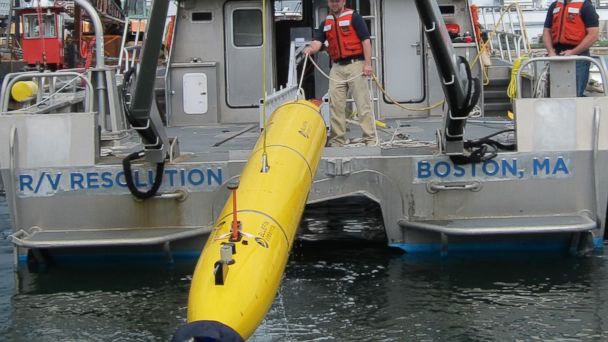US Sends Underwater Drone to Australia for Plane Search, Just in Case

The Bluefin-21 underwater vehicle, pictured as it is raised out of the water during testing. (Bluefin Robotics)
The United States is sending an underwater drone and a pinger locator to Australia in case a debris field is found for missing Malaysia Airlines Flight 370, military officials said today.
Malaysia's government asked the Pentagon on Friday to provide underwater surveillance technologies that could be used to help find the missing airliner.
U.S. Pacific Command is sending a Towed Pinger Locator (TPL-25) that would be able to find the plane's black box if a debris field is found, officials said. The device can listen for pings emitted from a plane's black box located as deep as 20,000 feet. The pinger locator was used in the recovery efforts for the Air France jetliner that went down in the Atlantic in 2009.
The Pentagon is also sending a Bluefin-21 autonomous underwater vehicle to Australia. The Navy uses underwater drones primarily to detect underwater mines, but the Bluefin is used for deep diving scenarios.
At a Pentagon news conference, Press Secretary Rear Adm. John Kirby described the Bluefin as basically an underwater unmanned vehicle "that has side-scanning sonar and what we call a multibeam echo sounder."
He said it is capable of operating at a depth of 14,700 feet and would be useful in distinguishing objects strewn in an underwater debris field should one be found.
Kirby emphasized that the equipment being sent to Australia as a precaution and should not be interpreted as a sign that a debris field has been found.
"We don't have a debris field that we can go look for specifically. We don't have anything to indicate where the aircraft is or even that it is down at the bottom of the ocean," he said.
U.S. Pacific Command's Admiral Sam Locklear made a "very prudent and wise decision to move the equipment that could be useful should a debris field be found or should we think we can get close to where the black box may be," Kirby said.
He added that Locklear felt the equipment should get underway now to speed up the search of a debris field if one is found.
Both devices will be placed aboard the Australian commercial ship "Seahorse Standard" should they have to go out to sea.
The equipment left New York's JFK International Airport this afternoon and would arrive in Perth sometime Tuesday.
Traveling along with the equipment will be two U.S. personnel, another eight will link with the gear in Perth to prepare the equipment should it be needed.